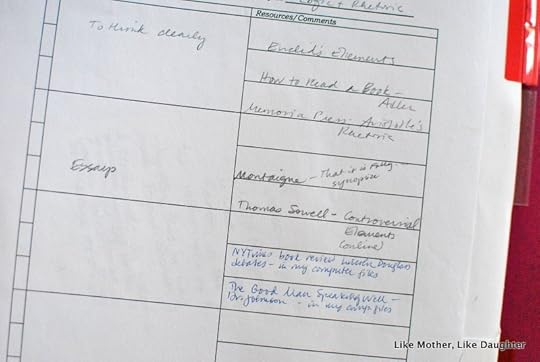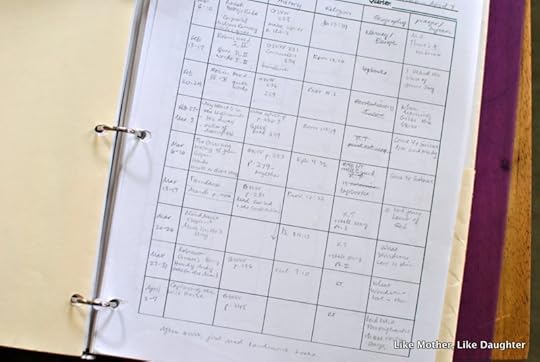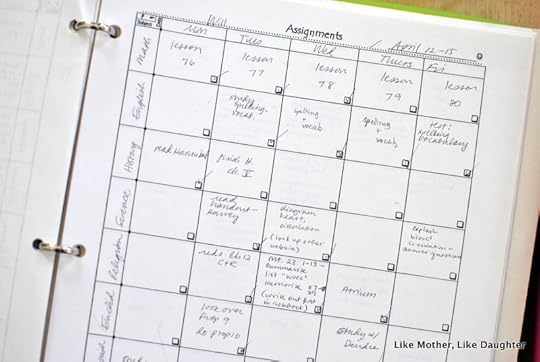Old-fashioned homeschool planning in a binder.
Today we’ll talk about my old-fashioned homeschool planning, for which I used a binder. This system really helped me get a handle on my curriculum, which I was always putting together myself (as opposed to the obvious sanity-saving measure of just buying a pre-packaged one, no thank you, not for me, I am not attached to my sanity!).
We’ve been having a nice organizing chat here, taking advantage of that January burst of energy, ahead of the February doldrums. (I have a suggestion for fighting off those February blues as well.*)
So far:
If your method of keeping a list of tasks works, go with it. If you need a new thought, how about To-Do’s using sticky notes? Key learning: Make a long list of to-do’s — but only ever focus on 3 to 5 of them at a time, because, well, that’s all you can really do day in and day out.
Make notebooks of your own. This could be mildly helpful to your organizing mojo or it could create a giant mess, but it’s fun and cute and finds a use for those sweet greeting cards you can’t part with.
Other ways and means, including the 5-year journal.
Deirdre dishes on her journal habit and her particular planner.
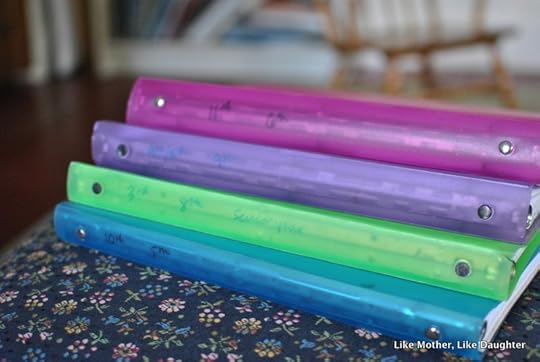
And what about homeschooling? I promised you I would show you what I did.
I went through years of homeschooling without ever really recording much at all.
Between using mostly old or free materials and my celebrated lack of commitment when it comes to complicated systems of record-keeping, the method I finally developed could be termed old-fashioned — or bare bones — or simply grossly inadequate.
But you asked!
I will say that psychologically/temperamentally, if you have a tendency to meander around, open dozens of tabs in the course of searching for curriculum ideas, and generally suffer from too many ideas, not too few — it might help to have things written down on paper.
Here in Massachusetts, we don’t have to do a lot of record-keeping in the home school. That fact is somewhat enabling to a lazy person like me. We did the work, but I didn’t record it very well. So this is what I developed (eventually), because actually, even for me — a person who homeschooled almost solely for the purpose of avoiding record-keeping and anything that threatens to be paperwork — having a paper trail is a good thing.
It’s good to be able to prove to yourself and to anyone who has the right to inquire that you are actually doing something in what feels like a jumbled up, blurry succession of days and weeks and months when the pregnancies, nights-long nursing sessions, toddler-wranglings, chauffeurings, and everyday family-life scenarios erase your memory.
Did we read? Did we do grammar? Fractions? French? Did anyone ever write a paper??
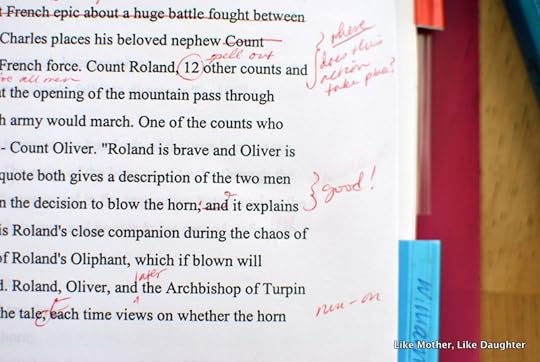
Bonus secret: If you keep a good record of what you did with child #1 in fifth grade, you will have most of the work already done for you when it comes to child #2! Not to mention child #7 who is coming along when you are lacking in, ahem, energy.
I know.
Duh, Auntie Leila.
For those of us who can’t help making up our own curricula, putting the work in writing, up front, is gold. I’m just telling you to save you from my fate. Let’s not re-invent those particular wheels!
How I did it, all disclaimers taken as read:
The binder is basically the “To-Do” list of your home school. Since by the time I figured this system out I was down to my last three kids, I put them all in one binder.
This binder is the outline for the year: one per year. It starts out rather slim, with sections. As the year goes on, the assignment sheet (one per child per week) gets filed after the fact.
In it, you collect your goals, book lists, any random materials that you foresee printing out and using (or come upon in the course of the year) such as black-line maps, extra math practice — anything that you want handy; and pockets for storing productions of the kids that need filing elsewhere, eventually. You can record grades, if you give them (and in high school, you might have to, depending on what colleges are in the offing. I know, it’s dumb.)
All the forms I use I found on the Donna Young site (or made from her inspiration). Again, I am now two years out of the homeschooling business and I made all my decisions before there were a ton of options — not like now. And I have no doubt that there are one bazillion options out there. Still, I will say that poking around on her site is very helpful! If nothing else, she gives you the idea of how to make your own forms. (I particularly like her history timeline forms and thoughts — because to me, a binder for the timeline is also the way to go.)
A binder is flexible. By now you know I like flexible.
In the binder, on the inside cover, put a copy of the school district’s calendar. Trust me. Many things in town go by this calendar, and it’s good to know when their vacations are so you don’t choose that week to go to the Science Museum or what have you. As you make your quarter plans (below), this calendar will be helpful to figure out when the weeks in the quarter actually are. It helps you build in breaks — important if you live in a neighborhood with public school children who will turn up at your door with sleds (I hope they will!!).
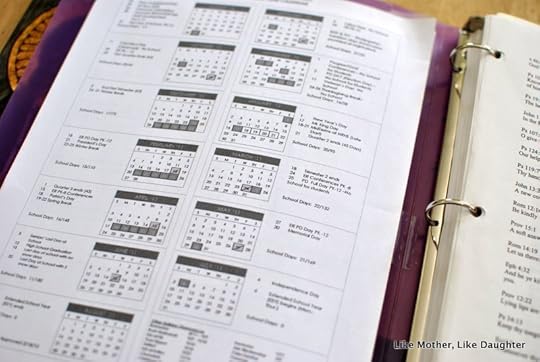
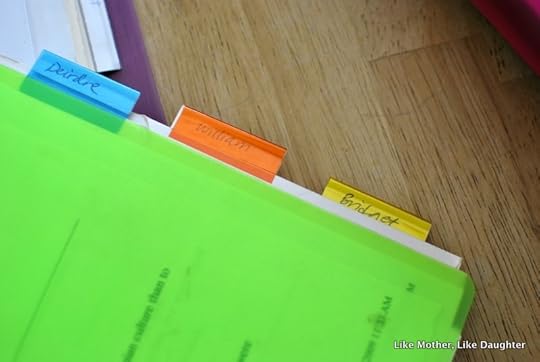
I start with a sort of book list of some kind — which, guess what, ends up being the curriculum. It’s by no means every book you will read in the year! Nor is it every thing you will do. But it’s the skeleton. (In Massachusetts, this is fine as a statement of the curriculum. Pop a cover letter on that bad boy, stating who’s being homeschooled, send it to the superintendent of schools in the district, and that’s it.)
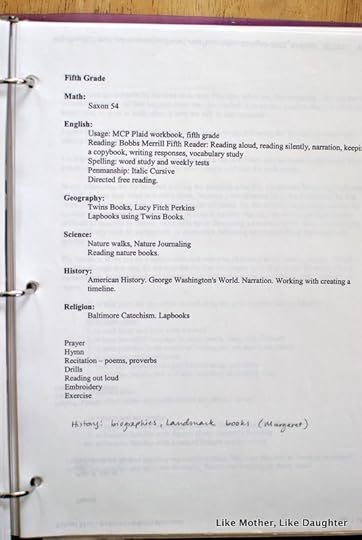
Now you will start to see that I went from the universal to the particular. After countless hours of intensive study and research, complete with grandiose fantasies of the ultimate, classical, Charlotte Mason–driven, and utterly charming year ahead, I would decide on what to do and read. Then I would work out the books I wanted to use. (This is not an easy thing to describe — where to get the books. I have a whole category of posts to direct you, and still don’t get the job done. You’re welcome.)
The Course of Study.
Then I would write out a “course of study.”
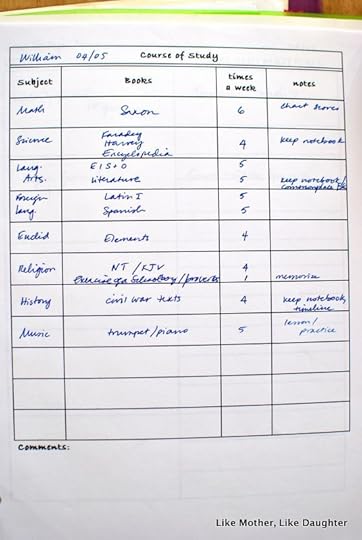
The Goal
Although at first I scoffed, I realized that I needed to be humble and write down my goals for each subject:
The goal of “logic and rhetoric” is “to think clearly.” Also, and not in a parallel fashion, “Essays.” But you get the idea.
Again, I think that Donna Young was a genius to encourage us to put this page in our planner. Sometime in February we are going to be wondering why the heck we are reading this random essay. And most importantly, when it comes time to teach the next 10th or 11th grader, we will not want to have to go through all the effort again!
For a sixth grader the goal of the year might be “to write a good sentence.” Usually by the middle of the year, homeschooling parents are in the grips of two opposing wishes: to give up on schooling entirely, and to teach that sixth grader to write like Hemingway. It’s good to open your binder to the “goals” page and read: “Goal: To Write a Good Sentence.” It comes in handy when all your friends are discussing the latest magic curriculum that gets your sixth grader to write like Hemingway.
For two years I homeschooled a friend of Bridget’s along with her. That responsibility didn’t quite shake me out of all my natural aversion to planning and recording, but it did make me a bit more official in writing down my goals:
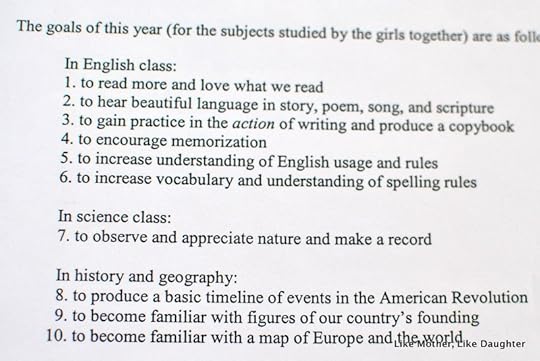
The actual book list was a separate page, but it was there.
The Quarter Planning Page
Because I was always putting together a curriculum (no matter how hard I tried to use a pre-packaged one), I needed Donna Young’s “quarter planner” so that I had an overview of the weeks.
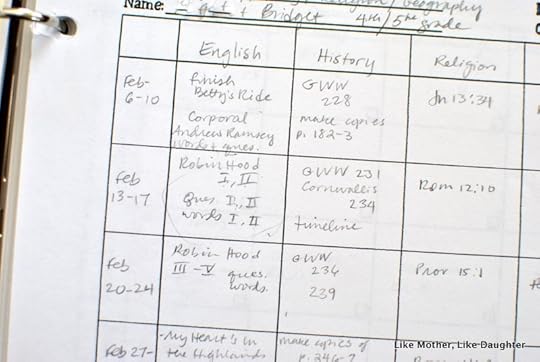
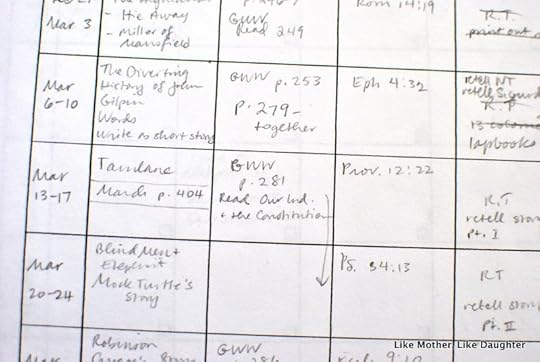
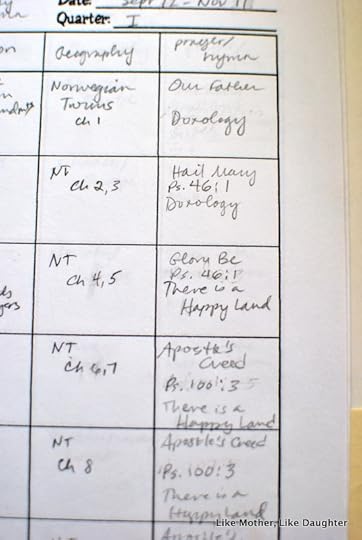
You can see that you need to make use of some abbreviations — thus, it’s really helpful to make a key of those abbreviations in your book list or at the bottom of the quarter plan. You know, for another year or another week when you have no idea what GWW could possibly ever, ever mean.
Pro-tip: If you want to teach a certain book, such as George Washington’s World, you don’t need someone’s packaged curriculum for that. You need the ability to divide up the book amongst the weeks! Looking at it, and considering your 5th grader’s ability to read and pay attention, you might decide that it will take you five weeks to read and study. (Perhaps it has five chapters, for instance — can’t remember, but that would be the idea.) This was by far the most difficult thing for me to wrap my mind around in my whole homeschooling career: You then plan it for five weeks. There are other books you want to read and study. Just line them up, divide them up, and record what you want to do in your quarterly planner. The good news is that math books are always keyed to a basic 180-day schedule, so you don’t have to worry much about dividing them up.
The Weekly Plan
Once you have your quarters mapped out (and there will be three quarters, not four — not in our homeschool, where summer is OFF!!), you can pretty easily come up with a weekly lesson plan. You are just consulting your quarter planner and fleshing out the week’s assignments, complete with activities that are scheduled in.
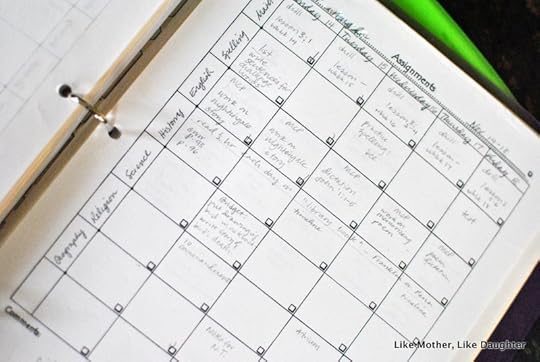
Although it is not pictured here, I recommend adding music and art along with their practices and lessons.
Eventually I figured out that if I printed out a week’s worth of work and posted it on the fridge, the child could see what was expected (rather than come to me every hour or so to ask what to do, or worse, just disappear), juggle his own assignments, check them off, and actually learn to manage his own time. And we’d still be on track to achieve our goals.
When a week’s work is done, file it in the binder on top of the quarterly form. At the end of the year you should have three quarter pages, in reverse order, separated by their respective weekly plans, also in reverse order. That is, when you open the binder, the May weekly plans should be on top.
As time went by, I did start doing these weekly plans out on the computer and printing them out. And now I see that Donna Young has a way to sync your plans on your Google calendar. So I’m sure all of this can be put online.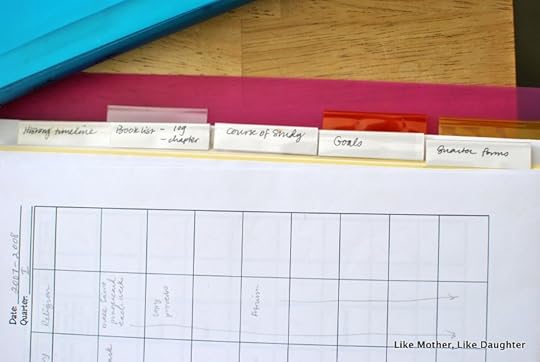
The binder helps you go from the general to the particular. It helps you keep a record. It keeps you from being at the mercy of your sudden bright ideas about the one true way to achieve enlightenment. And it’s flexible, because you can open it up and insert a page when you need to!
Making your own curriculum isn’t easy. But a homeschool planning binder really helps.
____________________________
*In addition to the bright ideas in that post, after reading this one, you can see how energizing it would be to be able to look at your goals and lists in your binder. “Oh, right, I already thought this through last August… “
The post Old-fashioned homeschool planning in a binder. appeared first on Like Mother Like Daughter.

